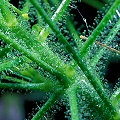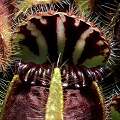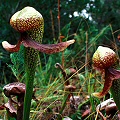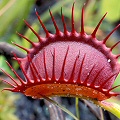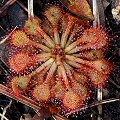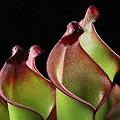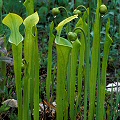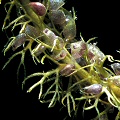| Heliamphora 'Cyclops' |
Carniv.Pl.Newslett.49:141 (2020)
Details |
CP Photofinder |
Cultivar: Heliamphora 'Cyclops' A.Smith
Publication: Carniv.Pl.Newslett.49:141 (2020)
Synonym: =Heliamphora tatei var. neblinae (Maguire) Steyerm. * Heliamphora folliculata Wistuba, Harbarth & Carow
Originator: A.Smith, Bournemouth, GB, 2010
Nominant: A.Smith
Registrant: A.Smith, 9. 6. 2020
Horicultural comment: Registered 23. 9. 2020 {JS}
Standard: Carniv.Pl.Newslett.49:97 (front cover) & 141 (2020)
Propagation: vegetative
Etymology: the nectar-spoon appears as a solid sphere, looking like a big, red eyeball
Description: Carniv.Pl.Newslett.49:141 (2020)
"Until now known as “H. neblinae × folliculata Clone 2â€, Heliamphora 'Cyclops' A.Smith is a large, robust, colorful, and wonderful thing (Front Cover). The pitchers are notably wide and chunky, over 30 cm tall and 10 cm across the open mouth (Fig. 3). Not as upright as its Heliamphora tatei var. neblinae (Maguire) Steyerm. mother, but not as decumbent as Heliamphora folliculata Wistuba, Harbarth & Carow. At up to 3 cm across, the nectar spoon is truly massive (possibly the largest in the genus yet seen?) red in color, downward-leaning into the pitcher and virtually spherical in shape, culminating in a blunt hook at its tip, underneath. The plant seems to concentrate on sheer size, and infrequently forms offsets. A mature, single-crowned plant might produce just one new basal rosette each year. The original plant is now 10 years old and has formed a 10 cm tall, 2 cm thick trunk (a trait I assume originates from the Heliamphora tatei var. neblinae (Maguire) Steyerm. parent) and this continues to grow, increasing in height at a rate of about 4 cm a year.
The plant has flowered twice, with several large (7 cm across the tepals) typical, white flowers of the genus held on a stalk around 70 cm tall. Recently, I have been successful in crossing this with H. exappendiculata, so its pollen is viable. (...)
A steady and easy-growing plant under conventional Heliamphora Benth. conditions, performing well in the greenhouse as well as under both fluorescent and stronger LED lights. Due to its overall height, a mature plant would probably be unsuitable for all but the tallest of terrariums. It flowers less often and produces fewer, but larger pitchers than most other members of the genus. Copious amounts of nectar is produced inside the spoon on warm days and can be seen dripping onto the back wall of the pitchers. Adult plants will require a large pot, at least 20 cm deep and possibly a supporting stake as it forms a trunk; those big, water-filled pitchers are heavy!"
|
| Heliamphora 'Patasola' |
Carniv.Pl.Newslett.46:157 (2017)
Details |
CP Photofinder |
Cultivar: Heliamphora 'Patasola' B.Tincher & J.Lei
Publication: Carniv.Pl.Newslett.46:157 (2017)
Synonym: =Heliamphora parva (Maguire) S.McPherson, A.Fleischm., Wistuba & Nerz * Heliamphora folliculata Wistuba, Carow & Harbarth
Originator: B.Tincher, London, Kentucky, and J.Lei, San Jose, Calif., US, "several years ago" (before 2017)
Nominant: B.Tincher
Registrant: B.Tincher & J.Lei, 18. 7. 2017
Horicultural comment: Registered 29. 12. 2017 {JS}
Standard: Carniv.Pl.Newslett.46:158, 160 (back cover) (2017)
Propagation: by rhizome division or cuttings
Etymology: after a South American myth
Description: Carniv.Pl.Newslett.46:157 (2017)
"It is unique among its siblings based on its vigor, rapid growth rate, and unique physical characteristics. It grew from seed to flowering adult in under four years. (...)
Mature pitchers are 25-30 cm tall and 5-6 cm wide. Under intense lighting, the pitcher color will become vinaceous to violet to almost charcoal as the pitcher ages. Pitcher shape is infundibular in the lower part with a pronounced waist approximately half way up. The upper section is infundibular and slightly compressed in older pitchers from front to back. This compression gives the pitcher mouth a kidney or reniform shape when viewed from above. The interior and exterior surfaces of the pitcher are puberulent to pubescent.
The rim of the pitcher mouth may undulate under some conditions and become revolute as it approaches the base of the nectar spoon. The revolute rim ends at the nectar spoon with little to no further constriction. The nectar spoon is helmet shaped with the bottom edge diagonally tapering to a point at the apex. It is a copious producer of nectar with droplets sometimes observed on the nectar spoon and exterior pitcher surface.
The inflorescence is pubescent with typical Heliamphora flowers. Productive bracteole nectaries have been observed under favorable conditions"
|
| Heliamphora 'Red Mambo' |
Carniv.Pl.Newslett.45:158 (2016)
Details |
CP Photofinder |
Cultivar: Heliamphora 'Red Mambo' F.Boullanne
Publication: Carniv.Pl.Newslett.45:158 (2016)
Comment: priority for (uncertain) parentage
Synonym: =?Heliamphora heterodoxa Steyerm. * Heliamphora tatei Gleason
Originator: "private collection", before 2014 ("years ago")
Nominant: F.Boullanne, Montreal, CA
Registrant: F.Boullanne, 19. 9. 2016
Horicultural comment: Registered 27. 1. 2017 {JS}
Standard: Carniv.Pl.Newslett.45:158 (2016)
Propagation: by rhizome cutting or division
Etymology: from nectar spoon color and shape reminiscent of mambo dance with wide movements
Description: Carniv.Pl.Newslett.45:158 (2016)
"I tried to produce seeds three times, under different growing conditions, but each attempt failed, so the plant is maybe sterile. The flower stalks are about 50 cm tall. It is a very slow grower, but vegetative propagation by rhizome cutting or division is quite easy, and the only method to keep the unique morphology.
The mature pitchers stand 18 cm or taller, colored green with red edges and veins. The pitcher outside is completely bald; the inside has a short white fuzz. The neck under the nectar spoon is fire red under good lighting.
The nectar spoon is very unique. Fully developed (under massive lighting of four 24w 6400k T5 fs), the nectar spoon is 1 cm long and about 0.3 cm wide. With a fire red "conquistador helmet" style, the nectar spoon also has a horned ending, pointing to the sky."
|
| Heliamphora 'Scylla' |
Carniv.Pl.Newslett.49:93 (2020)
Details |
CP Photofinder |
Cultivar: Heliamphora 'Scylla' I.Bogdanow
Publication: Carniv.Pl.Newslett.49:93 (2020)
Comment: priority for (uncertain) parentage
Synonym: =Heliamphora purpurascens Wistuba, A.Fleischm., Nerz & S.McPherson * Heliamphora ionae Maguire
Originator: A.Wistuba, Maselheim, DE, before 2017
Nominant: I.Bogdanow, Princetown, Mass., US
Registrant: I.Bogdanow, 25. 11. 2019
Horicultural comment: Registered 19. 6. 2020 {JS}
Standard: Carniv.Pl.Newslett.49:93 & 94 (2020)
Propagation: vegetative
Etymology: after large size of plant, pitcher morphology appearing to "reach out", and fluted pitcher opening looking like gaping mouths of the nymph in Greek mythology
Description: Carniv.Pl.Newslett.49:93 (2020)
"One of these seedlings ended in my possession and struck me with its excellent vigor, quickly recovering after import and rapidly increasing in size. At the time, the seedling was closer aligned to the pod parent. As the plant matured however, I realized I had purchased a very special plant indeed - the pitchers began to appear more fluted, the color intensified, and the spoons became very large. I took some time to research what the other seedlings of this cross might look like and found some that resembled Heliamphora purpurascens Wistuba, A.Fleischm., Nerz & S.McPherson even at maturity and others that were somewhat similar to my clone but lacked its vigor. The longer I grew the plant, the more impressed I became by its even half-and-half characteristics of the parents, its vigor, color, and size (including spoon size). (...)
Morphology: Pitchers large, typically around 25 cm long and 7 cm wide at maturity, though larger pitchers are possible; generally held at an angle on the rosette in a manner more extreme than Heliamphora purpurascens Wistuba, A.Fleischm., Nerz & S.McPherson but not quite as extreme as Heliamphora ionae Maguire; narrow waist and drainage hole present at slightly above mid-point (Figs. 7 & 8). The pitchers gradually flare out in the upper part to a wide opening with a pronounced triangular dip in the front. Nectar spoon large, 30 mm or more in width, helmet shaped with a triangular notch at the tip. Neck of spoon wide coming off a pronounced incurve on the back of pitcher. Spoon held at an acute angle from the pitcher opening. Interior of pitcher lined in small retentive hairs, size increasing near the waist area. Exterior subglabrous. Color green flushed red to bright red depending on light and season. Spoon always red. Plant displays good hybrid vigor, readily clumping, though not aggressively, more so than either of the parent species. Flowers white, up to 9 cm in width, 7 per stem."
|

